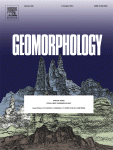Diversity in the geomorphology of shallow-water carbonate depositional systems in the Saudi Arabian Red Sea
(2014)
Highlights:
- A typology of Saudi Arabian Red Sea coral carbonate systems is developed.
- Using a GIS, sixteen system end-members are identified, mapped and tallied.
- Several types of carbonate system are present throughout the length of the Red Sea.
- Other carbonate systems are restricted to narrow sectors of latitude.
- Latitudinal distribution is explained by Red Sea tectonics and siliciclastic input.
Diversity in the geomorphology of shallow-water carbonate depositional systems in the Saudi Arabian Red Sea
 Geomorpholoy
Geomorpholoy
March 5, 2014
By Gwilym Rowlands, Sam Purkis, Andrew Bruckner
Coral reefs and their associated accumulations of carbonate sediment adopt particularly complex planform geometries atop the coastal shelf of the Saudi Arabian Red Sea. By assembling 95,000 km2 of remote sensing data into a GIS, this study aims to relate the morphology of these shallow-water depositional environments to processes that sculpt the coastal zone. A typology that sorts carbonate systems into end-members on the basis of their morphology and relationship to the coastline is developed. The resulting GIS was interrogated for spatial patterns in the distribution and abundance of the end-members. While several depositional morphologies are present throughout the length of the Saudi Arabian Red Sea, the occurrence of others is restricted to narrow regions of latitude. Such differences in distribution can be explained in process-terms by the rift tectonics of the Red Sea basin, spatial variability in the presence of sub-seafloor evaporites, and the input of siliciclastic detritus onto the coastal shelf via wadis. This paper provides a foundation for understanding the morphological diversity of shallow-water carbonate systems in both the modern ocean and rock records.
